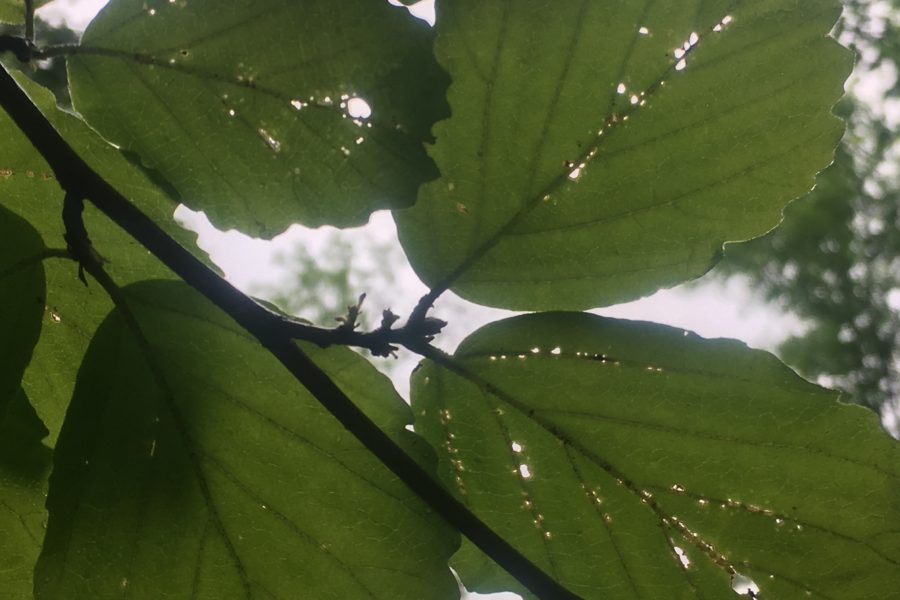Leaf mining activity on a small malus variety I have in my yard has reached my tolerance threshold, I think. Now action is required. Over the past two seasons I’ve watched the gypsy moth caterpillars cycle through their instar phases, growing bigger and bigger as the weeks progress. First, I observe the small ‘shot-hole’ symptoms indicative of inter veinal feeding on the leaves-the foreshadowing of the skeletonization. Weeks turn into months, June gets hotter than May, and as the leaves mature, the gypsy moths eat outward toward the drip line. It is sad for the tree, and great for the caterpillars. By the end of August, the tree reminds me more of Halloween.
I know that if this is a continuous cycle, and if the tree is defoliated for a third season in a row, stress levels will progress, the tree will suffer, and in the future possibly succumb to the feeding frenzy of the caterpillars. After defoliation has occurred, the young, vigorous tree will send out new leaves later in the summer. This second flush of growth requires tremendous amounts of energy and reserves. Coupled with the late season pressure of drought and disease, the stress from having to build new photosynthetic platforms in order to meet food demands can potentially be the final tax that the tree pays. Defoliation is a large expense in this case, and extremely draining on smart investments year after year.
There are many birds in our yard and so naturally, I consider them as one of the main biological predators of the gypsy moths. But I’m not sure if the caterpillars hairy body is appealing to the bird’s throat. I cringe just imagining having to swallow one. I’ve heard rumors of the the hairs causing irritation, so maybe those little whiskers are a strong physical defense against the robin or the jay. This sparks another thought: picking off the caterpillars by hand. Not eating them, of course, but maybe disposing of them in a plastic bag, or with a hot propane torch. My mind sifts through the mechanical control options. I have the thought that if birds and natural predators haven’t been able to subdue the quickened crawl of the gypsy moths, maybe something more synthetic is called for.
I watch the caterpillar’s body propel up the trunk in a tight, repeating wave. If I had to guess, I’d say they could easily cover two to four feet a minute. They are fast and efficient at ascending and eating. I watch one gypsy moth pass another on the trunk. Nearby is an old pruning cut with plump callous wood. Response growth (which also requires energy). They acknowledge each other with a momentary turn of the head. The markings on the tiny critters are beautiful. Royal and bold. They are everywhere on the tree.
David George Haskell writes in The Forest Unseen:
“Caterpillars are famously gluttonous. During their lives they increase their weight two or three thousandfold. If a human baby did the same, she would weigh nine tons, the combined weight of several marching bands, by adulthood. And, if the baby kept pace with the caterpillar, adulthood would arrive just a few weeks after birth. Caterpillars grow fast because their being is focused on just one task: eating leaves. Unlike adult insects they do not grow tough external skeletons, wings, complex legs, sex organs, or elaborate nervous systems. Such accoutrements would blunt the caterpillars’ focus and slow their growth. Defensive bristles are the only nongourmand elaboration that natural selection has allowed. By specliazing on the task of feasting, caterpillars have opened a business in which they have few rivals. In most forests they consume more leaves than all other herbivores combined,” (Haskell, 169-170).
I find myself on the internet after watching the gypsy moths for about twenty minutes. I’m reading the insecticide label of the product Sevin. Carbaryl (1-naphthyl N-methylcarbamate) is the active ingredient along with other inert material. I scroll down, by-passing warnings and suggested rates that don’t apply to my situation. I’m looking for the targeted pest for woody ornamentals list just to be sure. Bingo.
I know that I can do some damage to the Gypsy moth population with a good foliar spray application. But I think about the birds, and even the warblers which I haven’t seen many of yet. I know the summer commuting birds will help themselves to a few dead ones after the contact spray has overstimulated the caterpillars’ nervous system. But maybe the insecticidal dressing would act more like a bitter deterrent. And what about if ants begin to help themselves to the caterpillar corpses. Can the aftertaste of Carbaryl be tamed by a breath mint?
I guess I am at a crossroads of pest management. I feel as though picking off the gypsy moths on a tree this small would be the most organic and environmentally friendly option, but an industrious and painstaking route. A foliar spray is easy enough, and proven effective, but how will the ripple effect play out? A few dead caterpillars for a healthy tree doesn’t seem like a heavy price to pay; a few ounces per gallon and the problem is solved. Then again, a small part of me wants to see the gypsy moths ransack the crown. I want to revel in their persistence. I want to watch them grow bigger and hairier. I want to see them destroy their host in true biotic fashion.
It is a hot May night just before the dawn of June. The humidity is dense and pressing down upon the heavy, swelling heads of the peonies. The windows are open and the night is calm and dark. Beyond, in the still darkness, I can hear the shearing of leaves under tiny jaws.
I hope they aren’t coming for me next.





Leave a Reply
Your email is safe with us.